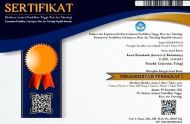FERMENTATION OF PORANG (AMORPHOPHALLUS MUELLERI B.I) WITH LACTOBACILLUS SP ON CALCIUM OXALATE, GLUCOMANNAN, AND PROTEIN CONTENT
Abstract
Porang (Amorphophallus muelleri B.I) is nutritional plant with high glucomannan (~ 55% on a dry basis). Porang has 5% to 80% oxalate of its weight, which harmful for health. This research examines method of reducing calcium oxalate and increase glucomannan using principle of fermentation in porang fermented flour products. This research was carried out using factorial RAK with bacterial type factors (L.palatarum and L rhamnosus) and fermentation time (three and five days) and repeated twice. The results were analyzed using SPSS 22 one way ANOVA test and followed by randomized block design test with factorial pattern at p< 0.05 using Duncan follow-up test to determine the differences between the treatments. Analysis of glucomannan and protein levels in porang fermented flour with Lactobacillus plantarum and Lactobacillus rhamnosus bacteria during three and five days of fermentation was influenced by the length of fermentation time, while the decrease in calcium oxalate levels in porang fermented flour influenced by the type of lactic acid bacteria used. The best fermented porang flour is porang flour fermented with Lactobacillus plantarum for five days with an increase in glucomannan levels of 145.19% and decrease in calcium oxalate and protein content levels of 61.29% and 14.66 respectively.
Keywords
calcium oxalate, fermented porang flour, glucomannan, Lactobacillus plantarum, Lactobacillus rhamnosus
Full Text:
PDFDOI: https://doi.org/10.31326/jbio.v6i1.1965
Refbacks
- There are currently no refbacks.
Editorial Office:
Fakultas Bioindustri
Universitas Trilogi
Jl. TMP Kalibata No.1
Jakarta 12760
Copyright Notice:











